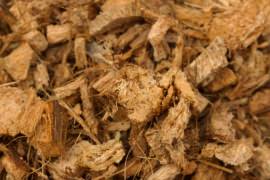Biocomposite materials
Post from EditorialsThe biocomposite materials represent a new frontier as far as the field of building in relation to the environment and man.
What does biocomposite means
By definition a biocomposite material, is nothing more than a material formed by a matrix, generally resin and a reinforcement element, it is usually made of natural fibers arising mostly from plants or cellulose. These types of materials have a wide use ranging from the field of biomedical, until you get to building.  The basic principle on which the formation of these materials is based, is that each of their components is biocompatible.
The basic principle on which the formation of these materials is based, is that each of their components is biocompatible.
These biocomposite materials are characterized by the fact that the resin matrix is essentially natural, therefore biodegradable, we speak of substances such as glass fiber, carbon fiber or even talc. Regarding instead the fibrous part, natural fibers are most often used wood fibers, hemp, flax, jute, etc. ..
The biocomposites start from the basic concept of FRP, Fiber Reinforced Plastics, namely by a combination of a polymeric resin and a reinforcing fiber, which make use only of the use of elements of plant origin, instead of exploiting the starting materials of synthetic origin, usually derived from petroleum processing, so definitely not safe for the environment.
We know that composite materials in their structure combine two or more starting materials, however, keeping them separate, thereby generating a third type of material created by the combination of the two, which has chemical and physical properties definitely better than the characteristics of the starting materials individually.
The matrix resin used, which in most cases is polyester, epoxy resin, vinyl resin or phenolic, has the ability to create cohesion between the various layers of fibers that are used, then glass fibers, carbon, boron, aramid fiber or fibers of vegetable origin.
 One of the most common composite material used in construction is reinforced concrete. In fact, the element of reinforced concrete steel and concrete, interact with each other without losing their initial material identity. In the construction field, many are composite materials that are used, generally with these are realized fabrics, grids, and acoustic-insulation panels, structural elements, as well as fabrics, felts, rubber sleeves for pipes, but also products in carbon, rather than fiber glass or rock wool.
One of the most common composite material used in construction is reinforced concrete. In fact, the element of reinforced concrete steel and concrete, interact with each other without losing their initial material identity. In the construction field, many are composite materials that are used, generally with these are realized fabrics, grids, and acoustic-insulation panels, structural elements, as well as fabrics, felts, rubber sleeves for pipes, but also products in carbon, rather than fiber glass or rock wool.The biomaterial instead represents the new generation of these materials and places a particular emphasis on their being sustainable and eco-efficient, using products that are derived from natural polymers and biodegradable plastics made from renewable crops from year to year, also using biomass as raw materials, forming a new portfolio of sustainable products, eco-efficient and competitive on international markets.
Advantages of the biocomposite materials
These materials are also called green biocomposites because the spread of plant fibers becomes more and more evident. We are speaking of renewable fibers such as cellulose plastics, polylactides, starch plastics/ plastics derived from starch, polyhydroxyalkanoates, soy-based plastics. All of these substances can be defined as green.
Many biocomposite materials are also using recycled materials or fibers derived from plants growing rapidly.
In this way, you significantly reduce the demand for products derived from petrochemicals or other fossil fuels. Also you prefer locally sourced products, thereby reducing the cost of transport. All these devices, related to the use of these new biocomposite materials, without doubt are able to ensure an increase in the welfare housing, coming to be fire resistant, thermally efficient, but sufficiently permeable to avoid the occurrence of mold inside of the built environment and at the same time ensure better indoor air quality.
All these devices, related to the use of these new biocomposite materials, without doubt are able to ensure an increase in the welfare housing, coming to be fire resistant, thermally efficient, but sufficiently permeable to avoid the occurrence of mold inside of the built environment and at the same time ensure better indoor air quality.
So in addition to an improvement in environmental terms, there was also an improvement in the welfare of human life.
Obviously, the decision to build a sustainable home with the use of biocomposite materials, helps to achieve LEED Certification, which, in addition to the prestige of the building, allows tax rebates and incentives.
Where do we use the biocomposite materials
In the field of construction the biocomposite materials have different types of application. For example we can find them in covering elements such as bamboo fiber panels, or as landscaping so as fences and decks made from derivatives of wheat and recycled plastics.
These materials are also used to carry out doors, in fact, the processing technology of bio-composites can produce fire doors derived from corn or sunflower.
Or even for the construction of walls and partitions inside an apartment. In fact, natural lime combined with hemp can form a concrete biocomposite, which, unlike traditional materials, at the end of its life cycle can be recycled as fertilizer.
79163 REGISTERED USERS










